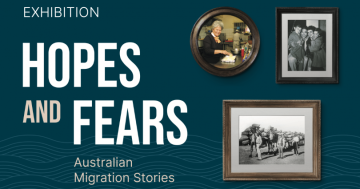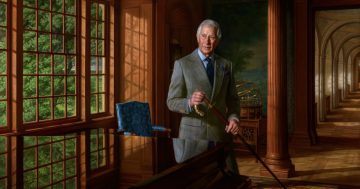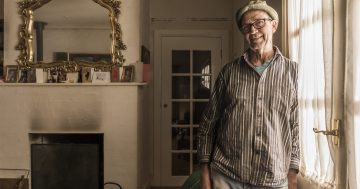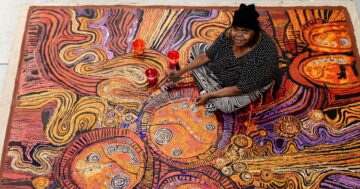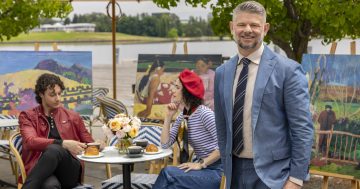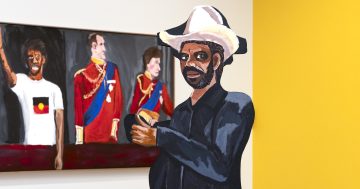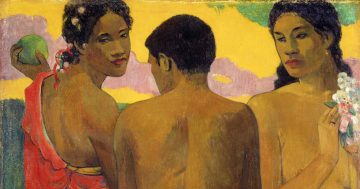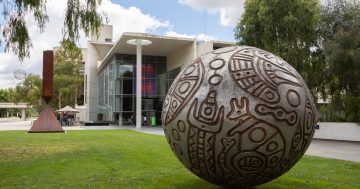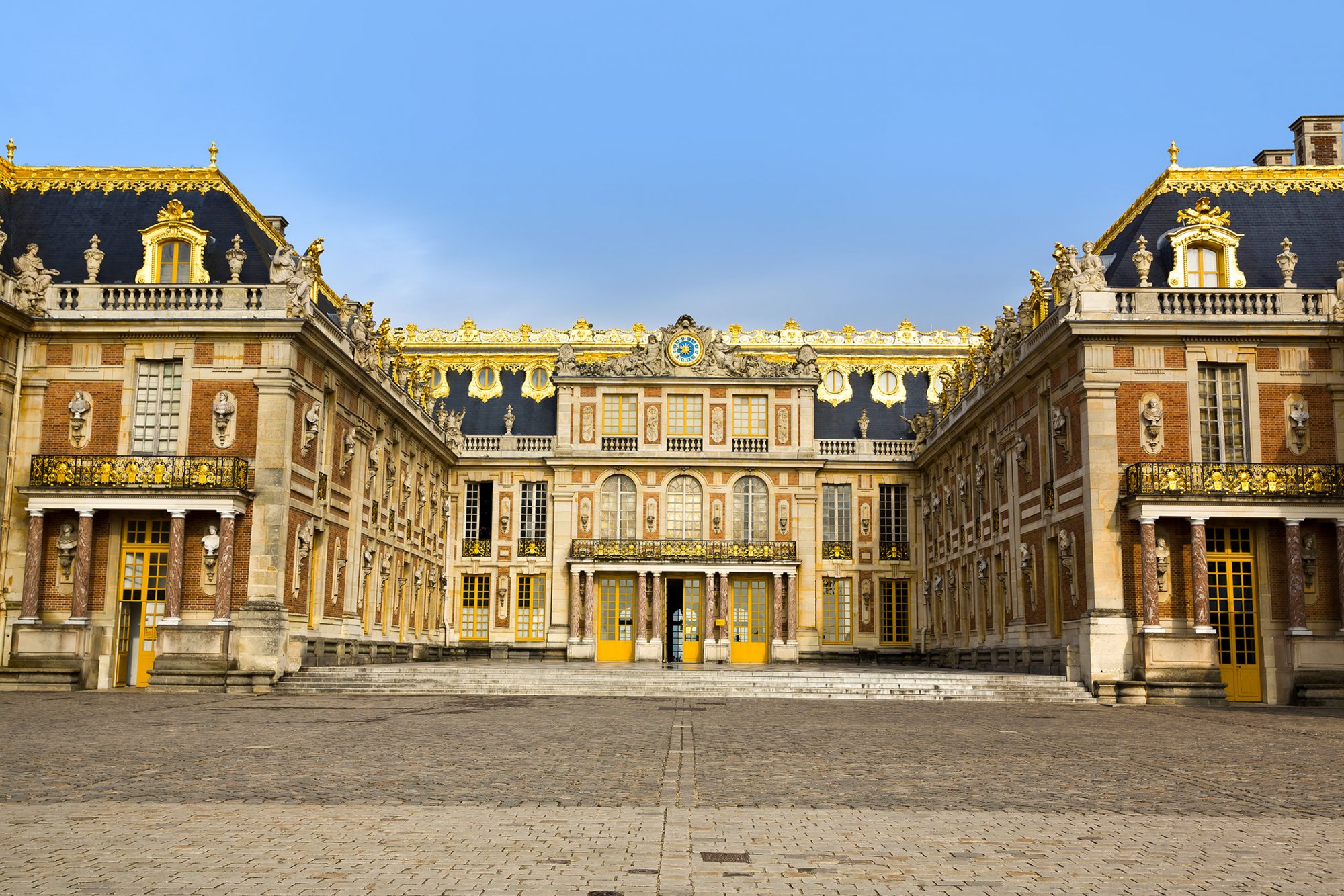 In a recent article, I described some of the artworks favoured by summer visitors to the National Gallery of Australia’s “Versailles: Treasures from the Palace”. It was fairly easy to see why these particular works resonated with the crowds, as so many are indeed show-stoppers.
In a recent article, I described some of the artworks favoured by summer visitors to the National Gallery of Australia’s “Versailles: Treasures from the Palace”. It was fairly easy to see why these particular works resonated with the crowds, as so many are indeed show-stoppers.
I have returned to look at more artworks in the exhibition and also some of the amazing people who created them: the artists and artisans of Versailles. The following are my personal favourites. I probably admire them most for their sheer craftsmanship, but I am also interested in process, materiality and the uniqueness of each individual work of art.
I also like to put the works into context: I think of the palace of Versailles and the vast gardens as the ‘universe’ of the Bourbon kings, setting the stage for a play or a grand pageant. The people who lived there were the actors – an amazing cast of characters – and the exquisite objects that surrounded them are the props. It seems every detail of every work has a story to tell.
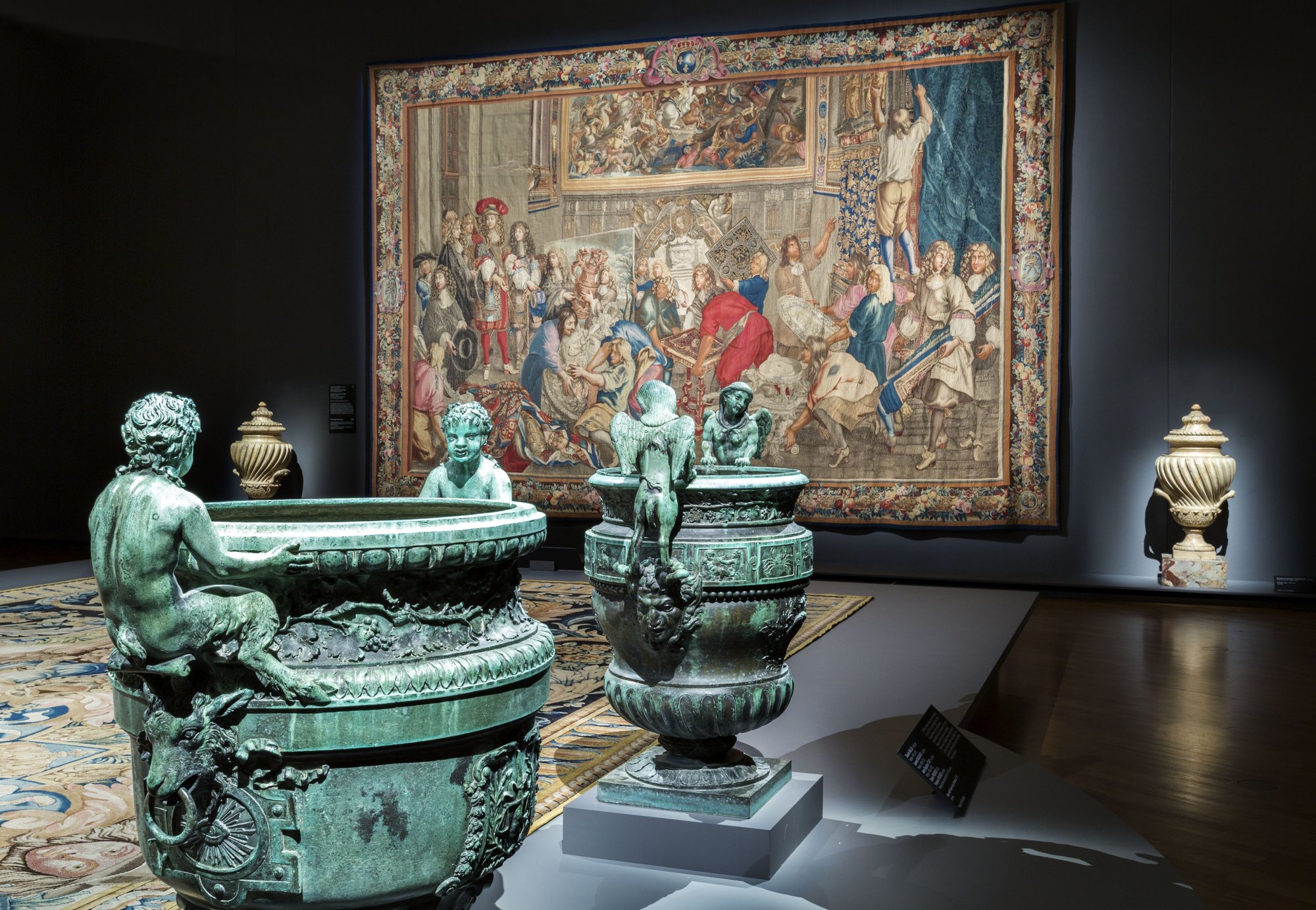 Visitors to this exhibition are quite dazzled by the beauty of the world of the Bourbon dynasty. The many portraits and paintings of various individual royals and family groups, as well as beautifully crafted objects evoke the lives, loves, taste and ideas of the king, queens, mistresses and courtiers who lived at Versailles for over 130 years. Visitors have taken advantage of their exhibition Gold Ticket and visited many times, seeking out what is below the top layer of glamour, gold, glitter, and paused to examine the individual works in detail. I have noticed people stand in front of a single painting, object or showcase for some considerable time, taking in the particular detail of individual pieces. As they slowly move away, they may turn back for one last look as they move onto something else that has piqued their interest. They are intrigued by the craftsmanship; the skills of the artists and artisans; paint application; collaborations; and artists trying to please their masters.
Visitors to this exhibition are quite dazzled by the beauty of the world of the Bourbon dynasty. The many portraits and paintings of various individual royals and family groups, as well as beautifully crafted objects evoke the lives, loves, taste and ideas of the king, queens, mistresses and courtiers who lived at Versailles for over 130 years. Visitors have taken advantage of their exhibition Gold Ticket and visited many times, seeking out what is below the top layer of glamour, gold, glitter, and paused to examine the individual works in detail. I have noticed people stand in front of a single painting, object or showcase for some considerable time, taking in the particular detail of individual pieces. As they slowly move away, they may turn back for one last look as they move onto something else that has piqued their interest. They are intrigued by the craftsmanship; the skills of the artists and artisans; paint application; collaborations; and artists trying to please their masters.
The life of the artists commissioned for various projects at Versailles would not have been easy. Painters would most likely have started as a student to a master in his studio, and training both in observation and application would have been developed by copying paintings. This method was in practice in many great art schools of the world until relatively recently. The high standards of craftsmanship that are obvious in each of the 130 works in the exhibition were achieved under Louis XIV and are evident in everything created right up until 1789. Two men in the court of Louis XIV were central to Louis achieving everything he did at Versailles. Charles Le Brun, despite his modest title of court painter, he was far more than that. As the ‘artistic director, or ‘arbiter of good taste’, Le Brun was responsible for creating decorative ‘ensembles’ that integrated architecture, painting, and sculpture with a sense of style both sumptuous and alluring. Louis’s Superintendent of Finance, Jean Baptiste Colbert wanted furniture made that would be suited to the magnificence of these buildings. For this purpose he gathered together some of the best craftsmen of the kingdom, men skilled in all kinds of arts and manufactures, especially painters, tapestry workers, sculptors, goldsmiths, cabinet makers. He cleverly attracted workers from other nations with promises of magnificent pensions and considerable privileges. It was this thinking that made Versailles an artistic and cultural magnet.
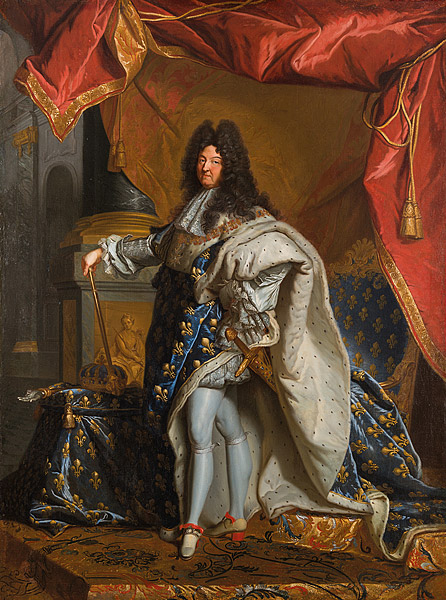
Louis XIV 1701-1712, from the studio of Hyacinthe Rigaud
This full-length portrait is from the studio of highly regarded court painter Hyacinthe Rigaud, a French Baroque painter of Catalan origins. In the frantic and competitive artistic environment that was Versailles, he was immensely successful. Regarded as a celebrity painter, he was prolific, and like all recognised artists, he had a studio and taught young artists. It is intriguing that this particular portrait is said to have been painted by assistants, with the exception of the face. The likeness of Louis’s face was painted on paper, and stuck on the painting. When the assistants had completed the majority of the work, Rigaud arrived and completed the work. It may have been a team effort, but this portrait captures the exact likenesses and naturalness, along with the detail of the king’s costume, considered to be an accurate record of contemporary fashion.What I find so different about this portrait isn’t so much that it is about the French King’s character, but about glorifying the power of the monarchy. Louis is the absolute ruler: dressed to the nines, his regal aura tells us about the universe of the Sun King, from the power-play red-soled shoes reserved only for royalty, through to his magnificent ermine cloak, and wonderfully haughty demeanour. Of interest to fashionistas will be the modern French shoe designer Charles Louboutin, who has mimicked the red soles of the king of Bourbon dynasty since the early 1990s, but proven litigious when anyone else tries to follow his lead.
This portrait was originally commissioned as a gift for Louis’ grandson, Philip V of Spain, however, it was so admired that Louis chose to keep it and sent a copy in its place. Louis’s stature, pride, power and aura is well caught. This painting was placed above the throne so that in Louis’s absence it served as a proxy; courtiers were forbidden to turn their backs on the painting. This work will immediately appeal to anyone who is interested in textiles, fashion and costume design, painting technique and composition.
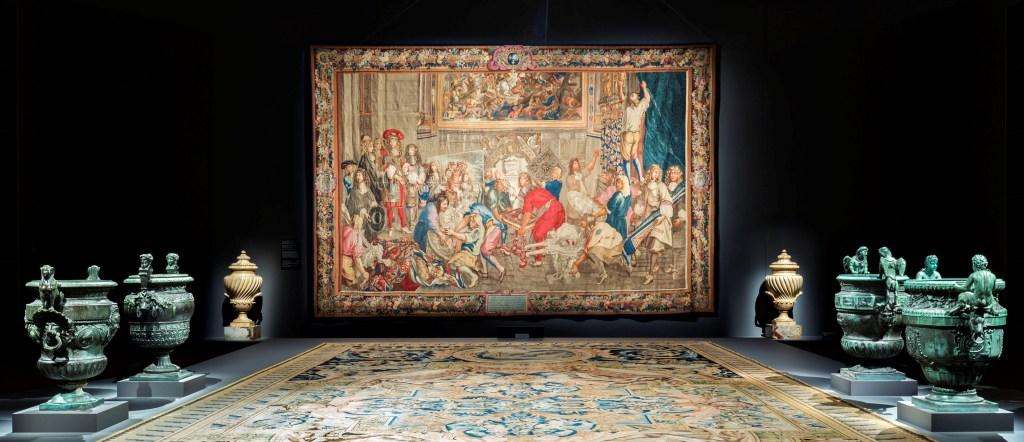 Another large work that I enjoy examining closely each time I pass is a huge tapestry (370 x 576 cm) designed by Charles Le Brun. This tapestry was woven at the Gobelins factory and is one of a series of 16 tapestries in the series “Life of the King” depicting important events in the epic life of Louis XIV. Unsurprisingly, the question that is most frequently asked about this work is how was it created? Tapestry weaving was one of the great medieval guild skills. Anyone who has been fortunate enough to visit the Victorian Tapestry Workshop will have observed how skilled the work of creating the closely woven surfaces is, requiring tapestry weavers to work intensively. The Gobelin is known for lengthy apprenticeships even today. Tapestry weavers train in the use of colour, as well as the refinement of even mark-making. No doubt working conditions of the weavers who created this tapestry were not easy, but better than other occupations. This work will be of interest to anyone who loves any form of weaving. I particularly enjoy Le Brun’s altering the picture plane in his design, giving us a clear view of the frantic scene. The tapestry documents the accumulation of the many rich treasures for Versailles. Highlighting just one day in the king, 15 October 1667, the left-hand side of the busy composition shows Louis XIV, Le Brun and Colbert engaging in their favourite pastime of checking out recently created treasures for Versailles. Unfortunately, we know that most of the beautiful silver pieces depicted did not last long. By 1689, the Royal Treasury was depleted after years of war, and the huge collection of silver furniture and objects was melted down to pay massive debts.
Another large work that I enjoy examining closely each time I pass is a huge tapestry (370 x 576 cm) designed by Charles Le Brun. This tapestry was woven at the Gobelins factory and is one of a series of 16 tapestries in the series “Life of the King” depicting important events in the epic life of Louis XIV. Unsurprisingly, the question that is most frequently asked about this work is how was it created? Tapestry weaving was one of the great medieval guild skills. Anyone who has been fortunate enough to visit the Victorian Tapestry Workshop will have observed how skilled the work of creating the closely woven surfaces is, requiring tapestry weavers to work intensively. The Gobelin is known for lengthy apprenticeships even today. Tapestry weavers train in the use of colour, as well as the refinement of even mark-making. No doubt working conditions of the weavers who created this tapestry were not easy, but better than other occupations. This work will be of interest to anyone who loves any form of weaving. I particularly enjoy Le Brun’s altering the picture plane in his design, giving us a clear view of the frantic scene. The tapestry documents the accumulation of the many rich treasures for Versailles. Highlighting just one day in the king, 15 October 1667, the left-hand side of the busy composition shows Louis XIV, Le Brun and Colbert engaging in their favourite pastime of checking out recently created treasures for Versailles. Unfortunately, we know that most of the beautiful silver pieces depicted did not last long. By 1689, the Royal Treasury was depleted after years of war, and the huge collection of silver furniture and objects was melted down to pay massive debts.

Either side of the tapestry are the Grand Vases created by Giovanni-Antonio Tedeschi, 1686 -86. At first, I thought they had a modest presence in the exhibition, despite their height of just over a metre. My opinion changed quickly when I learnt about their creation. Although little is known about Italian Tedeschi, he came from an important family of scarpellini; artisans who specialised in working with coloured marble. Unusually, he was commissioned to create the work outside the confines of Versailles in his home country.
The pair of substantial grand vases is admirable for the delicacy and quality of the carving, as well as the fine grain of the marble. What will also appeal to anyone who is interested in art, is this is a good example of recycled art. Recycled art in the 17th century? The lovely soft yellow marble had been sourced from three ancient Roman columns discovered in a vineyard of the Duchess of Mattei at her villa near Rome, famous for its statues and other antiquities. These two arrived at Versailles in 1687 and were installed in the Hall of Mirrors. The second commissioned pair arrived much later, as delivery was delayed by one of the many outbreaks of hostility in Europe during the Bourbon dynasty. They are an excellent example of an artist having a complex understanding of the material used, and the delicate design and technical skills will be of interest to anyone who has sculpted or loves sculpture.
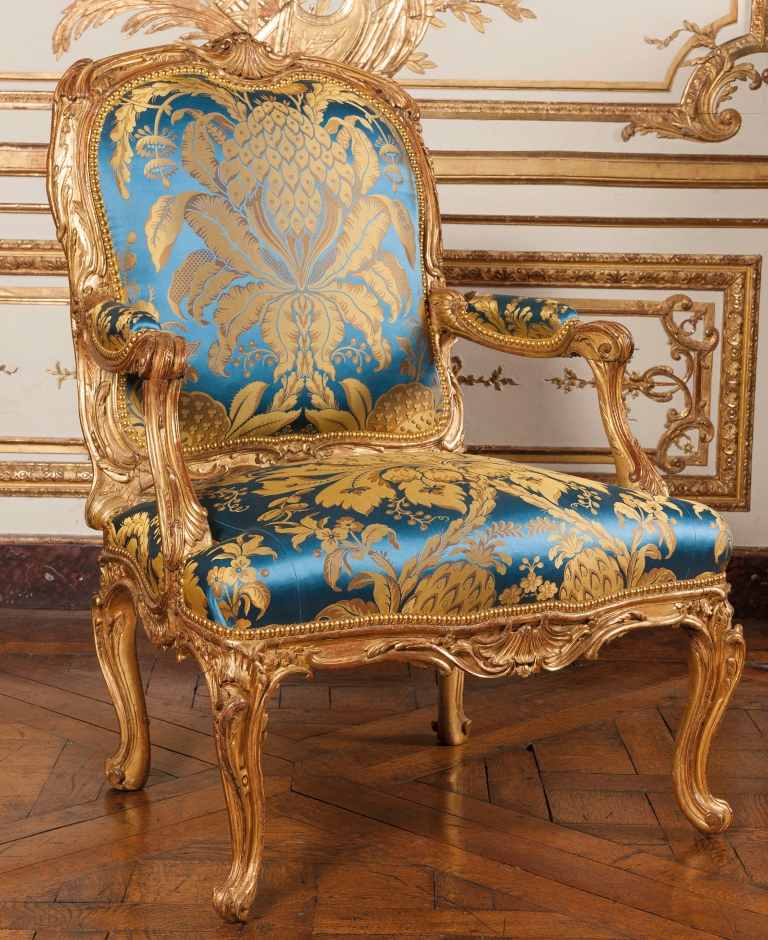
This elegant Rococo armchair (known as a fauteuil) was created for Madame de Pompadour, chief mistress (maîtresse-en-titre) to Louis XV. Designed for Madame de Pompadour’s residence at Crécy, it was a gift of the king in 1746. She continued to live at Crécy until she persuaded the king to build the Petit Trianon, although sadly it was not completed before her death. The beauty of this chair can be appreciated not just in the design and decoration, but also the exquisite upholstery in royal blue and gold woven silk fabric commissioned from the Gobelin factory. This armchair was part of a large suite of furniture, the result of a collaboration of a number of skilled artists and artisans. Nicholas-Quinibert Foliot was responsible for the joinery, with the carving attributed to his nephew Toussaint Foliot, and gilding applied by Gaspart-Marc Bardou. Madame de Pompadour placed an order for the silk upholstery with the request it “represent the different arts cultivated by young naked children”, after a design by the much admired François Boucher. It is truly a desirable piece of this exhibition.
The final choice is a few individual pieces from Marie-Antoinette’s “Pearls and cornflowers” service, created in 1781 at the Royal Porcelain Factory of Sevres. It is immediately obvious the service was not created for display, but was used, and used often. This extensive ‘soft paste’ porcelain service included salt cellars, egg cups, gravy pots, oil carriers, hors-d’oeuvres plates, as well as dishes for compote, sugar bowls glass buckets, and a punch bowl with 24 matching cups and saucers. Comprising 283 pieces, it took several months to complete and was delivered in 1782. Every piece was individually hand painted with cornflowers, both scattered in friezes and gathered in bouquets, with a pretty pale green trim with pearls. The purple-blue wildflower was a favourite of Marie-Antoinette and embellished many of the objects created for the Petit Trianon, suiting the image of the royal glamour of Versailles. Although only a small example of the extensive service is on display, close inspection reveals the beauty of the hand-painted flowers, and carefully applied gilt design. Soft-paste porcelain is somewhat of a curiosity to contemporary potters and ceramic artists. Extremely light, it is fired at lower temperatures than hard-paste with a light-coloured cream glaze applied with a brush. As it was difficult to throw soft paste porcelain on a potter’s wheel, this whole service was possibly created by hand. Holding up to the light (not possible in this particular exhibition!) the pieces reveal exceptional translucency and clear ‘stars’ . These are due to particles of ground glass imperfectly pulverised by the hand pestles and mortars used at that time.
Louis XIV is regarded by many as being responsible for the invention of the luxury goods industry in France. He created a stage setting so full of formerly unseen beauty that visitors came from all over the world to see the magnificence that was Versailles. Behind it was the manufacturing empire that created an extraordinary array of luxury goods: porcelain; glass and mirror; carved and gilded furniture; silk and fine linens; perfume and powders; cosmetics; wigs; and haute couture.
If you have ever stood in front of some beautiful luxury goods and wanted them all for yourself, just imagine how people felt over three centuries ago when they entered the palace of Versailles They were completely dazzled by the magnificence. Don’t miss your chance to see all the gorgeous things that are part of this unforgettable exhibition. Step back in time and try and imagine what life would have been like if you had been part of the magical universe that was Versailles.
“Versailles: Treasures from the Palace”, currently on exhibition at the National Gallery of Australia until 17 April (Easter Monday)
All photos kindly supplied by the National Gallery of Australia
Banner photo: The Palace of Versailles











